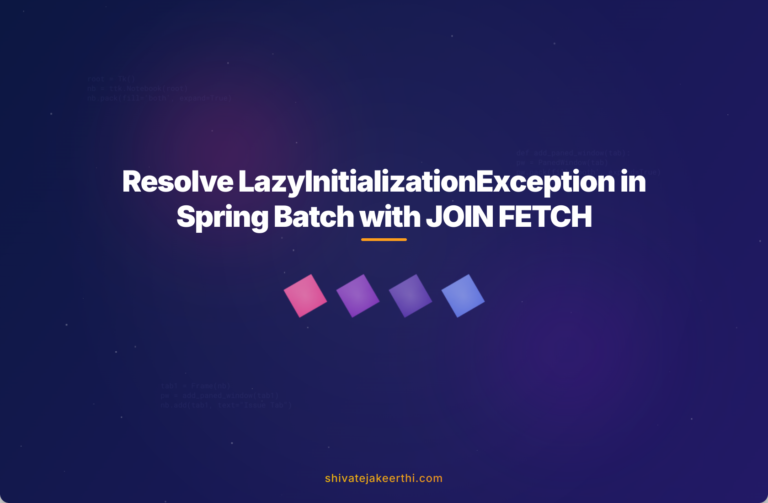Setting up an efficient, multi-threaded batch job in Spring Batch can significantly speed up processing time, especially when handling large datasets. However, developers frequently encounter a tricky obstacle—Hibernate’s LazyInitializationException. This error typically emerges when entities fetched from the database have lazy-loaded collections accessed outside their original transaction boundaries.
Spring Batch offers powerful functionality to enable multi-threading, but integrating it with Hibernate demands careful attention to session and transaction management. Let’s explore practical strategies to solve the LazyInitializationException issue effectively and smoothly enhance your batch jobs.
Common Challenges in Multi-threaded Spring Batch Jobs
When migrating from a simple sequential batch job to a multi-threaded approach, you immediately boost performance by utilizing multiple cores. But with concurrency, new problems surface rapidly.
One frequent issue is managing Hibernate entities within threads simultaneously. Hibernate’s default session management is not thread-safe. Since batch readers often fetch entities lazily—meaning fields and collections are fetched only when first accessed—you risk encountering errors related to sessions.
Specifically, Spring Batch readers, processors, and writers are executed in separate transaction scopes. Therefore, lazily loaded objects accessed in a different transaction than the one where they were initially fetched will throw a LazyInitializationException. This occurs because Hibernate detects no active session available to hydrate lazy-loaded attributes or collections.
Setup Components of a Spring Batch Job
A typical Spring Batch job consists of three core components:
- ItemReader: Retrieves data from a data source.
- ItemProcessor: Performs data transformations or validations and prepares the data for writing.
- ItemWriter: Writes processed data back to a database or file system.
For example, a common approach is using Spring’s built-in RepositoryItemReader, which leverages Spring Data repositories to fetch entities. A custom-defined ItemProcessor then processes domain entities, attached with Hibernate-managed lazy-loaded collections.
Implementing Multi-threading with ThreadPoolTaskExecutor
Spring Batch provides straightforward integration with multi-threading through the ThreadPoolTaskExecutor. Here’s how you might configure one:
@Bean
public TaskExecutor batchTaskExecutor() {
ThreadPoolTaskExecutor executor = new ThreadPoolTaskExecutor();
executor.setCorePoolSize(5);
executor.setMaxPoolSize(10);
executor.setQueueCapacity(25);
executor.initialize();
return executor;
}
Then simply inject this executor into your batch Step configuration, allowing the reader, processor, and writer to operate concurrently:
@Bean
public Step myStep(TaskExecutor batchTaskExecutor) {
return stepBuilderFactory.get("myMultiThreadedStep")
.<Entity, Entity>chunk(100)
.reader(myRepositoryItemReader())
.processor(myCustomProcessor())
.writer(myItemWriter())
.taskExecutor(batchTaskExecutor)
.throttleLimit(10)
.build();
}
The Root Cause: LazyInitializationException Explained
When executing multi-threaded batch jobs, developers commonly encounter unexpected exceptions such as:
- IllegalStateException
- NullPointerException
- ArrayIndexOutOfBoundsException
- LazyInitializationException
Among these issues, LazyInitializationException dominates when interacting with domain entities using Hibernate. A Hibernate session is akin to a memory scope within which entities’ lazy attributes are accessible. If the thread tries accessing lazy-loaded fields outside the original session, Hibernate throws the exception stating that no session or session context exists.
Imagine borrowing a library book with missing pages—you only discover the missing parts when you’ve brought it home. Similarly, Hibernate loads these “pages” (fields) only when requested and if the Hibernate “library” (session) is already closed, you can’t retrieve the pages needed.
Eager vs. Lazy Loading: A Quick Fix?
One immediate solution many developers attempt is switching from lazy loading to eager loading:
@OneToMany(fetch = FetchType.EAGER)
private List<Details> detailsList;
This approach resolves exceptions temporarily by loading everything upfront. But eager loading leads to severe performance degradation if not careful, especially if entities have numerous nested collections. Conversely, lazy loading defers fetching until necessary, significantly improving initial load times at the cost of potentially causing session-related exceptions.
While eager loading is workable, it isn’t always ideal. Therefore, developers explore alternative methods to retain lazy loading benefits without falling victim to exceptions.
JOIN FETCH Queries: A Promising Alternative?
JOIN FETCH queries represent another compelling approach. They allow specifically targeted lazy-loaded relations to be fetched alongside entities explicitly. For example:
@Query("SELECT e from Employee e JOIN FETCH e.detailsList dl WHERE e.status = :status")
List<Employee> findAllEmployeesWithDetails(@Param("status") Status status);
This fetch joins the lazy-loaded relationship, ensuring the collection is populated before Hibernate session closure. JOIN FETCH queries decrease the risk of LazyInitializationException while preventing unnecessary eager-loading pitfalls.
Implementing a CustomObjectProcessor
Your ItemProcessor logic can also help manage the lazy-loading challenge. An effective strategy might involve preemptively initializing lazy-loaded attributes during processing:
@Component
public class CustomObjectProcessor implements ItemProcessor<Employee, Employee> {
@PersistenceContext
private EntityManager entityManager;
@Transactional
@Override
public Employee process(Employee emp) {
emp = entityManager.merge(emp);
emp.getDetailsList().size(); // triggers initialization explicitly
performTransformations(emp);
return emp;
}
}
Explicit initialization ensures collections are available down the pipeline, resolving exceptions effectively.
Leveraging Custom Repositories and Querydsl
Using Spring Data’s QuerydslPredicateExecutor, you gain flexibility for dynamic queries. By combining Querydsl with JOIN FETCH scenarios, you improve entity loading capabilities tailored to performance needs, effectively mitigating lazy exceptions:
public interface EmployeeRepository extends JpaRepository<Employee, Long>, QuerydslPredicateExecutor<Employee> {
}
Queries dynamically handle fetch semantics and thoroughly eliminate the LazyInitializationException challenges.
Batch Job Configuration and Steps
A highly structured multi-step batch job clearly distinguishes responsibilities. Create separate steps for initialization, pre-processing, main processing tasks, and writing operations. Each step specifically addresses session boundaries—reducing exception risks inherently.
The multi-step framework explicitly controls transactions, making managing lazy-loaded entities more straightforward.
Handling LazyInitializationException: Strategy Recap
To summarize, effective approaches to solving Hibernate’s LazyInitializationException when implementing Spring Batch multi-threading include:
- Explicit initialization of lazy relations before session closes (JOIN FETCH, size() calls).
- Eager loading cautiously applied if necessary.
- Custom ItemProcessor implementations managing sessions explicitly.
- Multi-step batch configurations to clearly outline transactional boundaries.
- Effective use of Querydsl for targeted fetching scenarios.
Have you encountered similar LazyInitializationException issues in your projects? Feel free to share how you resolved them—or any effective tips related to Spring Batch multi-threading with Hibernate.



0 Comments